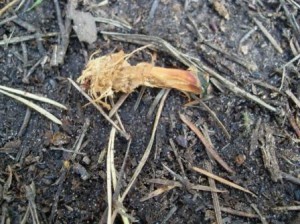In the firing line
Whilst patrolling the reserve last week I inadvertently became target practice for a dining squirrel.
The missile was the remains of a nibbled pine cone, with just the core left. A cone axis, as they are known, is a sure sign that something has had it for dinner. As this one fell out of the tree, it was almost certainly from a squirrel.
Squirrels have specific dining habits as discussed in the blog woodland dining. When taking the seeds from a cone they will start by gnawing at the base and working down the cone to the tip which they hold pointing downwards. The cone axis which is left will often have a frayed end like this one.

The scales nearer the tip of the cone are harder to gnaw off so they must brace the cone against the floor or a branch, as they gnaw through to the seeds underneath.
Individual squirrels, like humans, can be left or right handed. By looking at the pattern of gnawing on the scales, it can be established which paw they held the top of the cone with. Though there may be ambidextrous squirrels out there too . . .
Other creatures enjoy munching on pine cone seeds too. Wood mice are particular fans, but their discarded cones are much smoother in appearance than a squirrel’s.
Bye for now,
Rhian (Seasonal Ranger)
Help protect Scotland’s wildlife
Our work to save Scotland’s wildlife is made possible thanks to the generosity of our members and supporters.
Join today from just £3 a month to help protect the species you love.
Preface
Whilst patrolling the reserve last week I inadvertently became target practice for a dining squirrel. The missile was the remains of a nibbled pine cone, with just the core left. …
